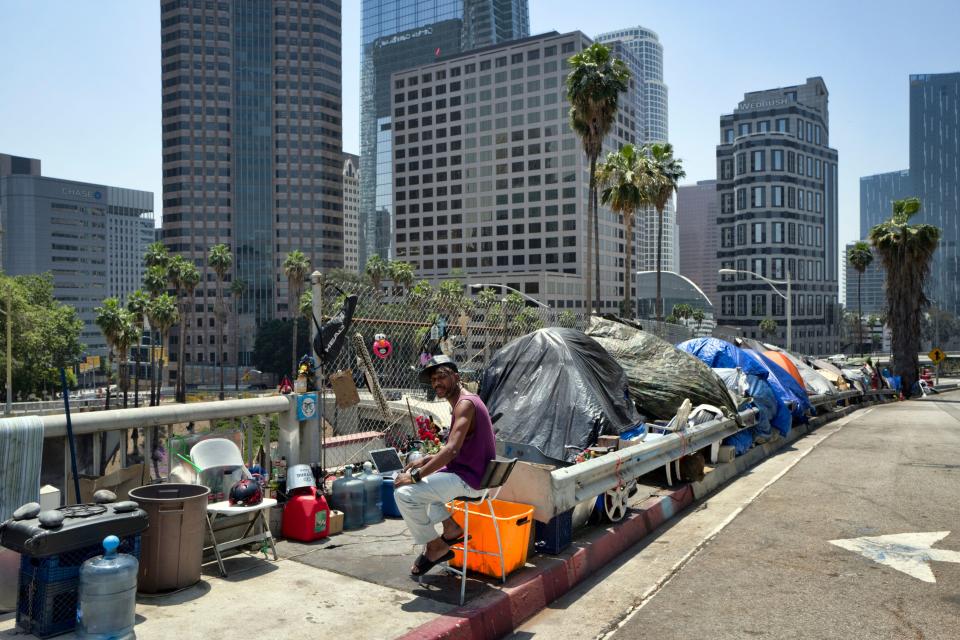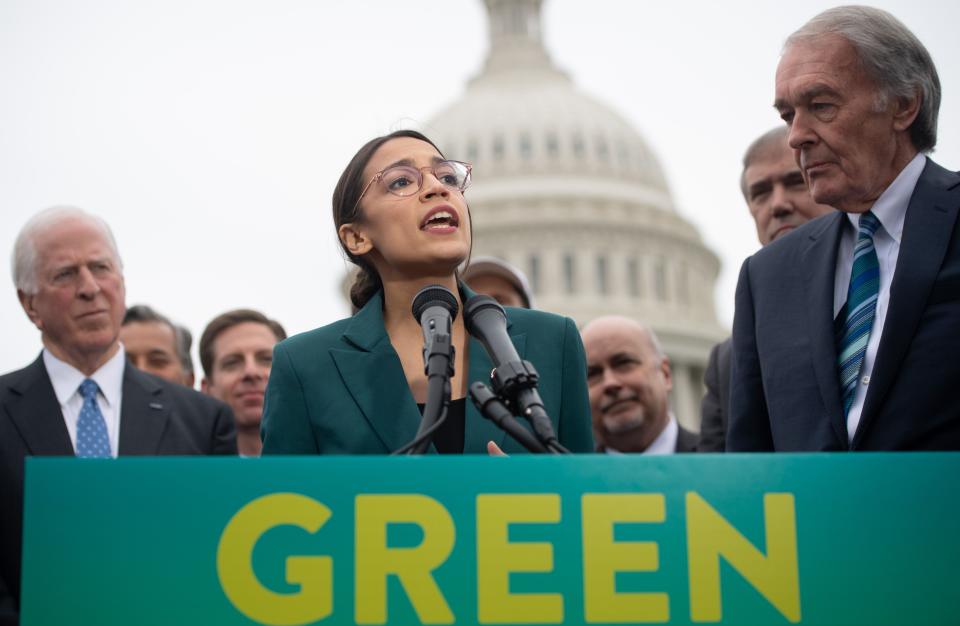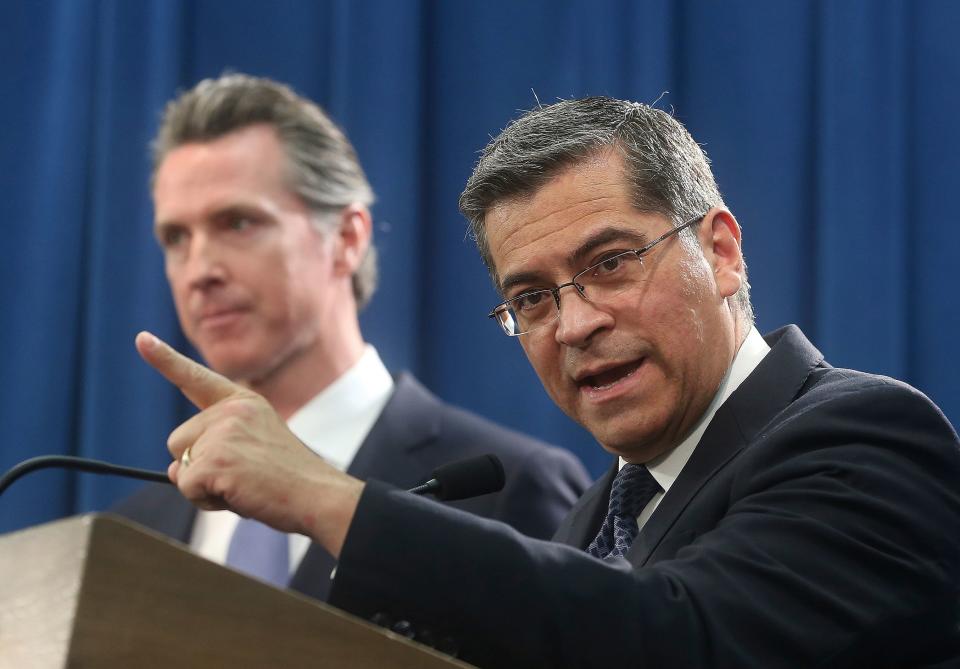As Trump battles California, Gov. Newsom makes big changes in first 100 days

SAN FRANCISCO — In the fall of 2009, this city’s leader vanished.
Mayor Gavin Newsom had been hoping to ride his controversial and prescient support of gay marriage in 2004 — nine years before the Supreme Court made such unions law — all the way to the statehouse in Sacramento.
But as his polling numbers slipped and coffers ran low, Newsom suddenly realized his bid for governor against state stalwart Jerry Brown was doomed.
For days, local media and even his own staffers could not find him. Newsom finally surfaced in Hawaii, licking his wounds with his wife and child. If the disappearance seemed petulant, it also spoke to his fierce desire for the job.
“He’d been soaring higher and higher politically as a very young man, but that aborted race for governor brought him crashing back down to earth,” said Nathan Ballard, who was Newsom’s spokesman at the time and remains a close advisor.
“Now, after champing at the bit for the role a decade ago, he’s tempered by age and wisdom and he’s not going to waste this opportunity," he said.
Nearly 100 days into his tenure as the state’s 40th governor, Newsom, 51, has already brought his signature sermonizing style to the state's highest office.
"The choices we make will shape our future for decades," he told lawmakers during his State of the State speech on Feb. 12. "This goes deeper than budget numbers or program details. This is about the bonds between us as human beings."
Newsom hasn't been shy about backing up such words with actions. His most recent: Traveling to El Salvador in early April to investigate the roots of the current immigration crisis.
Central American fact-finding mission: California Gov. Gavin Newsom meets Salvadorans who tried to reach US
In a mere few months, Newsom has taken enough bold stances to frustrate Republicans and cheer fellow Democrats. There's also an unmistakable signal to national party leaders — thanks to Newsom's photogenic looks, monied connections and youthful demeanor — that a 2024 presidential run could well be in the offing.
“Governors of California have always been potential candidates for president, so part of what he’ll try to do now is build a legacy to run on,” said Jack Citrin, a longtime observer of state politics and professor of political science at the University of California, Berkeley. “Newsom wants to do dramatic things, and it certainly seems like he’s starting off in that direction.”
Sen. Dianne Feinstein, D-Calif., a former San Francisco mayor herself, applauds Newsom's fast start, telling USA TODAY that he has identified "some of California’s biggest priorities including wildfire prevention and recovery and homelessness. We’ve already met once in Washington since he took office and we have a strong relationship."

One of those big priorities was his decision last month to use his power as governor to suspend executions of death row inmates, a move that had critics baying that the governor was ignoring the people’s will as expressed in recent votes against getting rid of the death penalty.
But there’s more. Newsom sued the city of Huntington Beach for failing to move forward with affordable housing measures, warning dozens of other local governments during his State of the State speech that the state would not tolerate attempts to skirt responsibility in helping solve a mounting housing crisis. City leaders countersued saying the overreaching move was unconstitutional.
Newsom also dove headfirst into the state’s expensive and often-derided high-speed rail project, immediately scaling back the vision to a singular run not on the coast but rather in the state’s arid Central Valley. That battle is far from over, as some Democrats lament the curtailed nature of the green-tech transportation vision while Republicans argue the entire project should be scrapped as impractical.
Early polls show clear divisions
USA TODAY asked Newsom’s office for its view on the first 100 days. A long memo followed outlining a dozen varied initiatives that speak to the governor's aggressive start.
Some highlights: On health care, Newsom signed an executive order giving the state more bargaining power with pharmaceutical companies; on education, he has proposed funding universal preschool; on immigration, he allocated $5 million to an emergency shelter in San Diego; on climate change, he preemptively declared a state of emergency in 200 communities likely to be susceptible to wildfires this year.
The memo also called out the formation of a new strike force to reimagine the state's broken and much maligned Department of Motor Vehicles, and the diversity of Newsom's appointments, which includes a staff that is 70% women.
Tackling California's less sunny side: California prison sued by inmates after maggots, mice fall into dining hall
Polls suggest that so far the new governor is pleasing many voters in a state that has always carried significant political and cultural sway over the rest of the nation. Helping out is the fact that California has taken a blue turn of late largely in reaction to Trump administration policies that have been antagonistic to the state, whether on issues of border security and immigration, or because of federal threats of withholding funds for wildfire disaster relief.

During the last midterms, Democrats unseated Republicans in many traditionally red regions of the state, notably in the south, and gave Newsom a supermajority in the Legislature to go along with a budget surplus left behind by Brown’s two terms that is predicted to hit $15 billion this year.
“Generally speaking, Newsom’s first 100 days have been successful in terms of connecting the dots between issues most voters care about and the things he’s indicated will be his priorities, ranging from fire prevention to the homeless,” said Mark Baldassare, CEO of the Public Policy Institute of California, a non-partisan research institution.
The Institute’s recent poll indicates Newsom has a 45% approval rating among the state’s adults and likely voters, while 26% disapprove. There are deep divisions among party lines, with 65% of Democrats polled approving of Newsom’s early moves while 65% of Republicans disapprove.
Echoing that divide, a poll from Reform California, a political action committee out of San Diego, indicates that while the same percentage (39%) favored and disapproved of his actions so far, 52% opposed his stand against the death penalty, and 54% opposed his decision to carry on with high-speed rail.
'Ignoring the will of the voters'
“One thing to remember is Newsom is operating at a time when things generally are very polarized in this country, and in this state, so it will be interesting to see what happens,” said Baldassare.
Perhaps predictably, interviews with lawmakers and stakeholders on both sides of the political aisle reveal fundamentally different views of the way Newsom is handing the reins of state.

“The governor’s first three months is full of mixed messages and overreach when it comes to ignoring the will of the voters on things like the death penalty, and I would hope he changes course because California deserves better,” said Vince Fong, a state assemblyman from the Central Valley who is a leading voice in the state’s Republican caucus.
“If Newsom says he wants to be bipartisan, I haven’t seen it,” added Fong. “There’s no monopoly on good ideas, and we Republicans have good proposals for building more roads, affordable housing and lowering taxes.”
Preparing for a coming wildfire season: California's secret wildfire weapon: Goats, sheep chew through flammable grass, brush
Harmeet Dhillon, a lawyer with Dhillon Law Group in San Francisco and the National Committeewoman of the Republican National Committee, is even more blunt. “When Gavin was mayor, he was a big business candidate,” she said. “Now he’s more left.”
She calls Newsom’s fight with Huntington Beach “woke posturing” that flies in the face of a raging homelessness problem in San Francisco that she lays at the former mayor’s feet.
Specifically, she charges that Newsom is beginning to cater to the progressive side of the Democratic party as exemplified by presidential candidate and Vermont Sen. Bernie Sanders and firebrand freshman U.S. Rep. Alexandria Ocasio-Cortez of New York.

“To make your way up through the machine of San Francisco politics, you actually have to be relatively moderate compared to an AOC or Bernie,” said Dhillon. “But once you arrive, you can pivot left and go off the rails."
Not bold enough for progressives
Some progressives, however, aren’t sure Newsom is swinging left enough.
“We’re looking for the governor to ban fracking outright and move us to renewable energy resources, and we need to see more out of his office on student debt and homelessness,” said Bill Honigman, California state coordinator for the Progressive Democrats of America, a group founded in 2004 to sway a centrist Democratic agenda.
Honigman, a retired emergency room physician, said Newsom also has to make good on his campaign promise to create a single-payer health care system in the state.
“We’re disappointed we didn’t get a piece of legislation for single-payer in Sacramento this session. He should be leading the way on this, so that’s a minus point in his column,” Honigman said.

But Newsom’s supporters feel confident these first 100 days is merely a taste of the ground-breaking politics that will come out of the state in the coming four years.
“Gavin has launched with a vision, and it is a reflection of a governor who’s going to be aggressive and forward leaning,” says Xavier Becerra, the state’s attorney general. “He’s acting on his values.”
Becerra’s office has so far nearly 50 lawsuits out against the Trump administration, legal actions that are helping Newsom sharpen a position that stands in defiance of many White House policies.
Becerra also is on point for the state’s various data privacy initiatives that include a data dividend, a revolutionary though still-vague call by Newsom for tech companies to pay users for the private information they capture online.

“Newsom understands he has a moment in history leading the fifth largest economy in the world, and my sense is he’s going to strike,” said Becerra. “The death penalty. High speed rail. Wildfires. He understands he’s here to help with all of that, and I hope he continues on this path.”
Gene Gantt, executive director of the California State Firefighters Association, a trade organization representing career and volunteer firefighters, said Newsom’s decision to spend his first day in office with first responders to announce a five-year, $1 billion forest management plan sent the right signal.
“We want to upgrade communications, get new firefighting technology, upgrade the 911 system in parts of the state, and the governor seems wide open to listening to our concerns,” said Gantt. “It helps that there is money now, which with past Legislatures we had to fight for.”
State Sen. Scott Wiener, a Democrat from San Francisco, said Newsom “is doing what he has always done, taking bold positions that sometimes are ahead of public opinion, much like he was way ahead on gay marriage. That’s what leadership is about.”
Wiener added “in California we’re willing to try new approaches to things and sometimes they work and sometimes they don’t, but we like our leaders to have national profiles and get out there and lead.”
The job is 'in his bones'
Few people know Newsom better than Ballard, his longtime friend and advisor, who currently runs The Press Shop communications firm.
Newsom, in Ballard's view, was a precocious political neophyte who quickly was tapped for greatness by San Francisco mayor-turned-kingmaker, Willie Brown. Backed by Brown and powerful, wealthy friends such as the Getty family, Newsom became mayor at the age of 36. In that role, he learned the sobering lessons of governing.
"You have to make the hard decisions," Ballard said over a coffee not far from Newsom’s former home in Marin County just over the Golden Gate Bridge. "He never pulled cops off the streets, and he always delivered a balanced budget."
Then came the national spotlight ignited by the debate over gay marriage, one in which California voters turned against Newsom by voting in 2008 for Proposition 8, which banned gay marriage, an initiative later ruled unconstitutional.
In being ahead of the social curve on gay marriage — "Something that is likely to be the first line in his obituary," said Ballard with a laugh — Newsom thought the governorship was his in 2009.
But Brown, a former governor and a steadying hand that ultimately helped deliver the state from a deep financial crisis, was what voters wanted.

Soon after his Hawaiian funk, Newsom learned that the largely ceremonial post of lieutenant governor was his for the taking, and he took it. What followed were eight years riding shotgun to Brown and time spent largely raising his four children with his documentary filmmaker wife, Jennifer Siebel Newsom.
Newsom was waiting, and then he pounced, spending much of 2018 criss-crossing a divided state talking about a "California dream" that he said still united all residents of the Golden State.
Today, Ballard describes his friend-turned-governor as a man driven by a sense of destiny.
“He’s not going to waste the platform,” Ballard said. “The end goal for him is to be a great governor of California for two terms. He has wanted this job in his bones, and the biggest setback of his professional life was when he had to withdraw in 2009. It was truly awful, I was there.”
Now, Ballard said, Newsom sees only an open field with plenty of room to run.
“Gavin has come out of the gate sprinting at an exhausting pace,” he said. “But it’s what I expected. He’s got a carpe diem attitude, one that says he has a limited time on this earth, and he’s going to do all he can with that time.”
Follow USA TODAY national correspondent @marcodellacava
This article originally appeared on USA TODAY: As Trump battles California, Gov. Newsom makes big changes in first 100 days

